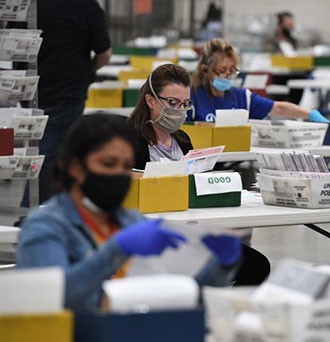
Nathaniel Stinnett launched the Environmental Voter Project in 2015 to resolve a simple but enormously important contradiction. Polls found a vast majority of Americans understood climate change and wanted the government to act. And while millions of those people were registered to vote, many never cast ballots.
Since then, his nonpartisan group has contacted nearly 6.2 million voters in a dozen states who rank environmental issues as a top concern, but rarely, if ever, vote. The group estimates that they’ve been able to convert just over 733,000 of those people into regular voters in the last five years.
Now the Massachusetts-based nonprofit is expanding into another five states: Alaska, Texas, Kansas, Iowa and New York.
“The climate movement’s problem is not a lack of solutions, it’s a lack of political power,” Stinnett told HuffPost this week. “We need to mobilize every day in every election in every state to amass so much political power that we’re impossible to ignore.”
The 17 states where his group will now operate in were not chosen at random. During its first major expansion in 2017, the Environmental Voter Project started contacting voters in Colorado, Florida, Georgia, Nevada and Pennsylvania, states that had large populations of non-voting environmentalists ahead of the 2018 midterm election. In 2019, the group added six more battleground states ― Arizona, Virginia, New Mexico, North Carolina, New Hampshire and Maine ― to its list ahead of the 2020 election.
The local elections this year are a golden opportunity to start building a green wave for 2022.
These next five are slated to hold major elections this year, including choosing new mayors in some of the nation’s largest metropoles. And the Environmental Voter Project has identified millions of eco-conscious ballot-box slackers to target in each of them.
“The local elections this year are a golden opportunity to start building a green wave for 2022,” Stinnett said. “If we only get involved in voter mobilization every two or four years when there’s some big, sexy federal election, oh my gosh, are we taking a big risk. We can’t win at every battle, so we need to grab at every opportunity we can.”
In Anchorage, Alaska, where voters are set to pick a new mayor on April 6, Stinnett and his team have already begun calling and texting some 12,000 registered voters. In New York City, where the mayor and a majority of the city council were term-limited this year, Stinnett found some more than 1 million potential “environmental super voters.” In Texas, where San Antonio elects a new mayor on May 1 and a possible new governor next year, the Environmental Voter Project set its sights on at least 530,000 voters.
The expansion has coincided with record fundraising. The group raised about $475,000 in 2017. In both 2018 and 2019, it hauled over $1.5 million, with roughly 2,000 of donors contributing $100 or less and help from some big backers like billionaire British financier Jeremy Grantham. By 2020, that number ballooned to nearly $2.7 million, with more than 7,000 donors contributing $100 or less.
To identify voters, the Environmental Voter Project builds profiles based on the kind of demographic and behavioral data advertisers use, then performs a series of surveys to verify the data and determine how likely voters are to list environmental issues as their top political priority. The group then runs the profiles through an algorithm that scores voters based on how likely they are to be “super environmentalists.” Finally, it weeds out people whose public voting records show they turn out for most elections.
Then Stinnett, a veteran campaign strategist in Boston, begins some old-school canvassing: knocking doors, texting, calling and sending mailers. The messaging rarely if ever touches on environmental or climate issues. Rather, the Environmental Voter Project’s 6,000 volunteers typically shame voters for missing elections in which their neighbors cast ballots, remind them when and where the next polls are and promise to follow up.
Those follow-ups mean the Environmental Voter Project didn’t catch a break after the 2020 election. First, it poured more resources into the Jan. 5 Georgia Senate runoffs that saw two climate champions defeat two climate deniers. Immediately afterward, the group started canvassing voters in the Feb. 9 district attorney race for Georgia’s Griffin Judicial Circuit, one of 150 local elections across the country the nonprofit has worked on since the start of January.
“If you really take seriously the idea of turning nonvoters into voters, you really can’t take an election off,” Stinnett said. “You can’t view the act of voting as a series of one-off transactions. It’s not. It’s a potentially habitual behavior you can reinforce.”
The result has benefits that can cut across party lines. Stinnett pointed to attack ads the National Republican Congressional Committee ran in Florida in 2018 accusing Democrat Debbie Mucarsel-Powell of accepting money from coal donors.
“It was a completely disingenuous attack, but that’s beside the point,” Stinnett said. “The NRCC has no problem with the fossil fuel industry, but they can read a poll as well as anybody can read a poll. And what they saw in South Florida is there’s an enormous amount of environmental voters.”
But it’s an issue that’s particularly ripe for Democrats, particularly as President Joe Biden prepares a broad slate of new climate regulations and seeks to pass hefty new legislation in Congress. A post-election survey in December from Navigator Research found climate change was the No. 1 motivating issue for 18-to-44-year-olds who backed Biden in 2020 after not voting or voting for a third party in 2016.
“Democrats have the opportunity to lean into climate change as a way to keep people in the Democratic coalition and make sure they turn out in the midterms,” said Jared Leopold, a party operative and co-founder of the climate policy group Evergreen Action. “If you’re a Democratic candidate and want to turn out the vote, you should be talking about climate change.”
